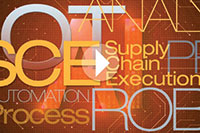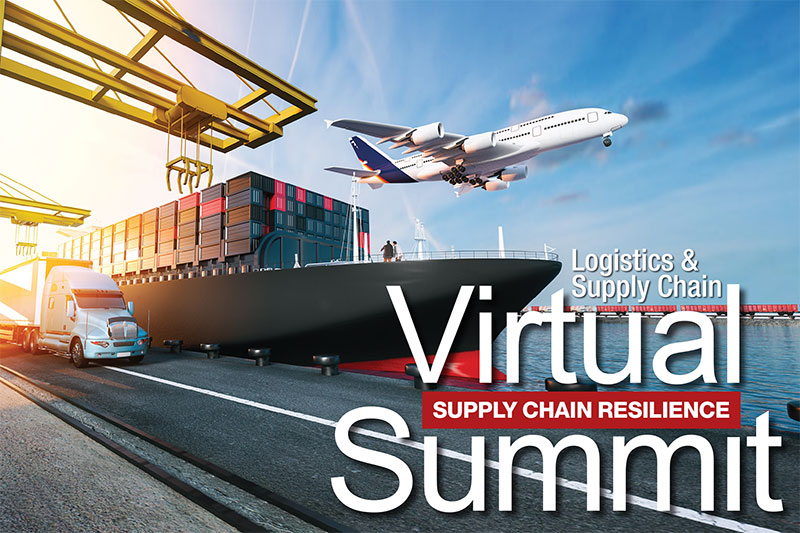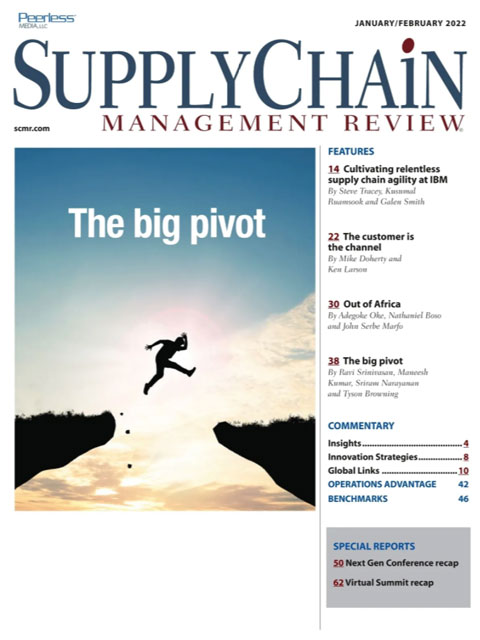Sorry, but your login has failed. Please recheck your login information and resubmit. If your subscription has expired, renew here.
January-February 2022
Well, that’s over, and aren’t we all glad to put 2020 in the rear-view mirror? For a minute, however, let’s look at a silver lining, because I think there is one for supply chain managers. That’s because the pandemic put supply chain in the spotlight like never before—and, with the approval of a vaccine just a few weeks ago in December, supply chain and cold chain are back in the news… While sales usually gets all the attention, maybe 2021 is our time to shine.” That’s the beginning of the column I wrote for the January 2021 issue, and maybe I was a little too pollyannish. Browse this issue archive.Need Help? Contact customer service 847-559-7581 More options
The events of the last two years pushed many logistics and supply chain operations to the brink, ushering in capacity, pricing, inventory, fulfillment, labor and global trade challenges that many have never seen before—and they may never experience again. As the challenges continue, fulfillment pressures continue to mount around the globe, where the need for more flexibility and scalability has become paramount.
These realities have put a premium on the adoption of new strategies, technologies and automated systems that will help companies tackle what’s in front of them while also preparing for future disruptions and gearing up for inevitable growth.
In our 2021 Virtual Summit, the editors of Logistics Management and Supply Chain Management Review put the spotlight on some of the game-changing strategies and automated solutions that leading organizations are already using to gain an advantage in the marketplace.
The event features an all-star lineup of keynote speakers, industry experts and analysts. They provide practical tips for evaluating, implementing and leveraging these tools in an effort to streamline operations and build resilience into logistics and supply chain operations.
Keynote
Post-pandemic Global Supply Chain: Deglobalized or decoupled?
 The ongoing crisis is making deep and sweeping changes to global and regional economies—some are going to be ephemeral, while others will be permanent. However, one trend, which has been underway in recent years, has been greatly accelerated: the reshaping of global supply chains.
The ongoing crisis is making deep and sweeping changes to global and regional economies—some are going to be ephemeral, while others will be permanent. However, one trend, which has been underway in recent years, has been greatly accelerated: the reshaping of global supply chains.
In his keynote, Nick Vyas, executive director of USC’s Center for Global Supply Chain Management, discusses how global supply chains looked very different in 2021 versus how they looked just a few years ago.
“For the first time in decades, if not centuries, the supply chain is at an inflection point,” says Vyas. “There’s no question that we all agree as professionals that disruption due to COVID-19 was significant. In fact, it actually created disruption across 160+ countries and every imaginable continent.”
Vyas also discusses the “decoupling” of global supply chains, where instead of having a worldwide network of interconnected supply chain nodes, there will be regionally concentrated supply chain networks. Each of those networks will be connected to other regional supply chain networks through a decoupling point that, acting as a buffer, protects that regional supply chain network from demand shocks.
“The supply chain continues to evolve rapidly, technological advancements are crucial to maintain the integrity of your supply chain and see your business succeed,” says Vyas, who suggests that the audience focus on digital transformation; become more predictable and less reactive; and continue leveraging innovations like smart vehicles, drones, the Internet of Things (IoT) and augmented data intelligence.
Session 1:Transportation Research
30th Annual Study of Logistics and Transportation Trends
 Technology is enabling and driving changes in the way that companies move, store and deliver goods and services. The “30th Annual Study of Logistics and Transportation Trends (Masters of Logistics)” sets out to gain insights into the impacts of these changes as well as how technology and other factors are affecting and shaping the “human” aspects of logistics and transportation.
Technology is enabling and driving changes in the way that companies move, store and deliver goods and services. The “30th Annual Study of Logistics and Transportation Trends (Masters of Logistics)” sets out to gain insights into the impacts of these changes as well as how technology and other factors are affecting and shaping the “human” aspects of logistics and transportation.
In this session, Christopher A. Boone, Ph.D., assistant professor at Mississippi State University and Karl B. Manrodt, Ph.D., professor at Georgia College and State University, put context behind the findings of the study and share how top logistic operations are leading the way when it comes to the adoption and support of technology in transportation.
The speakers explore both strategic and digital trends while also focusing on the “people” side of digital transformation in logistics and transportation. “Most people think the role of relationships will be diminished, or the importance of people will diminish, and I really don’t see that happening anytime soon,” says Manrodt.
Boone and Manrodt walk through the results of the study and discuss how transportation trends have changed over the years. They also provided insights and advice to companies that are working through challenges and planning ahead.
“Companies still need to understand what it is that they do, how they’re going to be competitive in the market and what differentiates them,” said Boone, “and then figure out what are the technology solutions that enable and support that strategy.”
Session 2: Software
Supply Chain Software: Elevate the expectations of your WMS
 Whether it’s detecting unusual or sudden spikes in demand, automating the ordering process, streamlining transportation, ensuring effective stock utilization or making warehouses more efficient, software is playing an increasingly important role in supply chain management.
Whether it’s detecting unusual or sudden spikes in demand, automating the ordering process, streamlining transportation, ensuring effective stock utilization or making warehouses more efficient, software is playing an increasingly important role in supply chain management.
In this session, Kail Plankey, senior systems consultant at St. Onge Company, and Howard Turner, the company’s director of supply chain execution systems, look at how companies of all sizes can better utilize their existing warehouse management systems (WMS) to drive efficiency and flexibility while proactively positioning themselves for success.
They kick off their session by talking about the hidden opportunities that exist within current systems that companies are unaware of. “It’s very rare that we walk into a situation where we see a company that we can say is fully utilizing all the capabilities and all the functionality in an existing system,” says Turner.
The speakers also highlighted the most important areas of the DC—receiving, putaway, replenishments, slotting, travel path, inventory control and outbound staging—and show how companies can use technology in each of those areas.
Then, they discuss how supply chain manager can eke more functionality out of an existing WMS. “We strongly recommend initiating an exercise within your company,” Turner suggestions, “to determine if there are opportunities to better utilize existing WMS functionality in some of the most important areas of the DC.”
Session 3: Automation/e-commerce
Think before you leap
 According to Peerless Research Group’s “2021 Warehouse and Distribution Center Equipment Survey,” companies are balancing the need for high-velocity operations with limited labor resources, all while meeting the ever-changing needs of their customers.
According to Peerless Research Group’s “2021 Warehouse and Distribution Center Equipment Survey,” companies are balancing the need for high-velocity operations with limited labor resources, all while meeting the ever-changing needs of their customers.
These trends are driving more companies to invest in automation, which is helping organizations solve the most pressing fulfillment problems. Automated storage, voice-directed picking, conveyor-based picking, mobile robots, unit sortation and software are some of the tools being used to manage disruption, support current and future employees, and preserve service levels.
Ian Hobkirk, founder and managing director of Commonwealth Supply Chain Advisors uses this session to discuss the transformative nature of automation in the warehouse. He also talks about the challenges and risks that companies encounter when they attempt to automate their operations.
“Automation is a very important decision for any company to make and is not to be taken lightly,” says Hobkirk, who understands that supply chain executives are being bombarded with more options than ever, and right at a time when labor is both scarce and expensive. “For companies considering this type of project, there are really more options than ever before for automating distribution centers.”
To choose automation wisely, Hobkirk suggests starting with a thorough review of current pick methodologies. “There is no universal formula to figure out the best technology, but there are some key design criteria,” he adds, “so always make sure you get objective, independent advice on the best fit from someone other than the automation provider.”
Session 4: 3PL
Shippers and 3PLs: New ways of innovating together
 Over the last few years, the 3PL market has become increasingly crowded and fragmented with a mix of global and local providers, as well as new players emerging with more user-friendly services and digital platforms.
Over the last few years, the 3PL market has become increasingly crowded and fragmented with a mix of global and local providers, as well as new players emerging with more user-friendly services and digital platforms.
According to Sarah Banks, Accenture’s managing director, global lead freight & logistics, 3PLs are now looking to up their games. This is happening as shippers reevaluate 3PLs to ensure that they’re getting the most from these relationships as the recovery unfolds.
“Supply chain complexities are something that everyone now understands more intimately, just with the amount of disruption we’ve been seeing,” says Banks. She discusses the continuation of COVID-19 impacts (i.e., service reliability, capacity constraints, uncontrolled costs, labor shortages and supply chain shifts) and said the changes present both opportunities and challenges.
Banks also talks about shippers’ expectations of their 3PLs, with end-to-end services, better experiences, proactive insights and a purpose aligned to their values as some of the key “must haves” that are on companies’ shopping lists right now.
Session 5: Robotics
State of Robotics 2021: Scoping a solution
 In this session, Jeff Hedges, president at JHedges Consulting, gives attendees an in-depth look at the different types of robotic solutions on the market. He puts the spotlight on some of the hottest trends, examines the value proposition behind these various approaches and explores how operations can better align robotics, automation and the workforce.
In this session, Jeff Hedges, president at JHedges Consulting, gives attendees an in-depth look at the different types of robotic solutions on the market. He puts the spotlight on some of the hottest trends, examines the value proposition behind these various approaches and explores how operations can better align robotics, automation and the workforce.
Hedges discusses the current trends for robotic arms, the various applications, the technology growth and what you need to know when considering robotic arms. He also gives his outlook for what to expect in the future of that technology as more companies integrate robotics into their warehousing and fulfillment operations.
“Robotic arms are certainly past the beta stage of development and ready to go mainstream,” Hedges predicts. He’s also seeing growing adoption across many industries outside of the warehouse such as agriculture, medical, food service and food production.
Current robotics applications include repetitive application in manufacturing, item picking, put-walls, pallet build and auto trailer unloading. Expect more applications to emerge in the hear future. “Looking forward,” Hedges concludes, “software and deep learning are the keys to future growth.”
Session 6: Global
Domestic Sourcing: It’s time to bring manufacturing back
 Reshoring and near-shoring have been part of the supply chain conversation for over a decade. That conversation got louder during the trade wars, and again as logistics and supply chain managers face one pandemic-driven disruption after another.
Reshoring and near-shoring have been part of the supply chain conversation for over a decade. That conversation got louder during the trade wars, and again as logistics and supply chain managers face one pandemic-driven disruption after another.
In this Virtual Summit session, Rosemary Coates, president of Blue Silk Consulting and executive director of the Reshoring Institute brings her 40 years of global supply chain and trade experience to the table to discuss the strategies global supply chain managers need to consider before redesigning their supply chains. She talks about how offshoring to China was popularized by U.S. manufacturers in the 1990s and 2000s.
“The mood of America has changed,” Coates says, and mostly due to rising tariffs, the pandemic, intellectual property protection, advanced technologies, government incentives, reduced environmental regulations and corporate economic patriotism. “The pandemic was really a game changer and we’ve found that the interest in domestic sourcing, as well as reshoring overall, has increased exponentially.”
Coates also discusses a recent Made in the USA Survey, which shows that 70% of consumers prefer products made in the United States and 60% say they’re willing to pay more for such products. This is just one of many trends that are driving manufacturers to onshore and reshore some or all of their manufacturing operations. “Americans prefer products made in the USA,” says Coates, “believe they are of higher quality and are willing to pay more for them.”
SC
MR
Sorry, but your login has failed. Please recheck your login information and resubmit. If your subscription has expired, renew here.
January-February 2022
Well, that’s over, and aren’t we all glad to put 2020 in the rear-view mirror? For a minute, however, let’s look at a silver lining, because I think there is one for supply chain managers. That’s because the… Browse this issue archive. Access your online digital edition. Download a PDF file of the January-February 2022 issue.The events of the last two years pushed many logistics and supply chain operations to the brink, ushering in capacity, pricing, inventory, fulfillment, labor and global trade challenges that many have never seen before—and they may never experience again. As the challenges continue, fulfillment pressures continue to mount around the globe, where the need for more flexibility and scalability has become paramount.
These realities have put a premium on the adoption of new strategies, technologies and automated systems that will help companies tackle what’s in front of them while also preparing for future disruptions and gearing up for inevitable growth.
In our 2021 Virtual Summit, the editors of Logistics Management and Supply Chain Management Review put the spotlight on some of the game-changing strategies and automated solutions that leading organizations are already using to gain an advantage in the marketplace.
The event features an all-star lineup of keynote speakers, industry experts and analysts. They provide practical tips for evaluating, implementing and leveraging these tools in an effort to streamline operations and build resilience into logistics and supply chain operations.
Keynote
Post-pandemic Global Supply Chain: Deglobalized or decoupled?
 The ongoing crisis is making deep and sweeping changes to global and regional economies—some are going to be ephemeral, while others will be permanent. However, one trend, which has been underway in recent years, has been greatly accelerated: the reshaping of global supply chains.
The ongoing crisis is making deep and sweeping changes to global and regional economies—some are going to be ephemeral, while others will be permanent. However, one trend, which has been underway in recent years, has been greatly accelerated: the reshaping of global supply chains.
In his keynote, Nick Vyas, executive director of USC’s Center for Global Supply Chain Management, discusses how global supply chains looked very different in 2021 versus how they looked just a few years ago.
“For the first time in decades, if not centuries, the supply chain is at an inflection point,” says Vyas. “There’s no question that we all agree as professionals that disruption due to COVID-19 was significant. In fact, it actually created disruption across 160+ countries and every imaginable continent.”
Vyas also discusses the “decoupling” of global supply chains, where instead of having a worldwide network of interconnected supply chain nodes, there will be regionally concentrated supply chain networks. Each of those networks will be connected to other regional supply chain networks through a decoupling point that, acting as a buffer, protects that regional supply chain network from demand shocks.
“The supply chain continues to evolve rapidly, technological advancements are crucial to maintain the integrity of your supply chain and see your business succeed,” says Vyas, who suggests that the audience focus on digital transformation; become more predictable and less reactive; and continue leveraging innovations like smart vehicles, drones, the Internet of Things (IoT) and augmented data intelligence.
Session 1:Transportation Research
30th Annual Study of Logistics and Transportation Trends
 Technology is enabling and driving changes in the way that companies move, store and deliver goods and services. The “30th Annual Study of Logistics and Transportation Trends (Masters of Logistics)” sets out to gain insights into the impacts of these changes as well as how technology and other factors are affecting and shaping the “human” aspects of logistics and transportation.
Technology is enabling and driving changes in the way that companies move, store and deliver goods and services. The “30th Annual Study of Logistics and Transportation Trends (Masters of Logistics)” sets out to gain insights into the impacts of these changes as well as how technology and other factors are affecting and shaping the “human” aspects of logistics and transportation.
In this session, Christopher A. Boone, Ph.D., assistant professor at Mississippi State University and Karl B. Manrodt, Ph.D., professor at Georgia College and State University, put context behind the findings of the study and share how top logistic operations are leading the way when it comes to the adoption and support of technology in transportation.
The speakers explore both strategic and digital trends while also focusing on the “people” side of digital transformation in logistics and transportation. “Most people think the role of relationships will be diminished, or the importance of people will diminish, and I really don’t see that happening anytime soon,” says Manrodt.
Boone and Manrodt walk through the results of the study and discuss how transportation trends have changed over the years. They also provided insights and advice to companies that are working through challenges and planning ahead.
“Companies still need to understand what it is that they do, how they’re going to be competitive in the market and what differentiates them,” said Boone, “and then figure out what are the technology solutions that enable and support that strategy.”
Session 2: Software
Supply Chain Software: Elevate the expectations of your WMS
 Whether it’s detecting unusual or sudden spikes in demand, automating the ordering process, streamlining transportation, ensuring effective stock utilization or making warehouses more efficient, software is playing an increasingly important role in supply chain management.
Whether it’s detecting unusual or sudden spikes in demand, automating the ordering process, streamlining transportation, ensuring effective stock utilization or making warehouses more efficient, software is playing an increasingly important role in supply chain management.
In this session, Kail Plankey, senior systems consultant at St. Onge Company, and Howard Turner, the company’s director of supply chain execution systems, look at how companies of all sizes can better utilize their existing warehouse management systems (WMS) to drive efficiency and flexibility while proactively positioning themselves for success.
They kick off their session by talking about the hidden opportunities that exist within current systems that companies are unaware of. “It’s very rare that we walk into a situation where we see a company that we can say is fully utilizing all the capabilities and all the functionality in an existing system,” says Turner.
The speakers also highlighted the most important areas of the DC—receiving, putaway, replenishments, slotting, travel path, inventory control and outbound staging—and show how companies can use technology in each of those areas.
Then, they discuss how supply chain manager can eke more functionality out of an existing WMS. “We strongly recommend initiating an exercise within your company,” Turner suggestions, “to determine if there are opportunities to better utilize existing WMS functionality in some of the most important areas of the DC.”
Session 3: Automation/e-commerce
Think before you leap
 According to Peerless Research Group’s “2021 Warehouse and Distribution Center Equipment Survey,” companies are balancing the need for high-velocity operations with limited labor resources, all while meeting the ever-changing needs of their customers.
According to Peerless Research Group’s “2021 Warehouse and Distribution Center Equipment Survey,” companies are balancing the need for high-velocity operations with limited labor resources, all while meeting the ever-changing needs of their customers.
These trends are driving more companies to invest in automation, which is helping organizations solve the most pressing fulfillment problems. Automated storage, voice-directed picking, conveyor-based picking, mobile robots, unit sortation and software are some of the tools being used to manage disruption, support current and future employees, and preserve service levels.
Ian Hobkirk, founder and managing director of Commonwealth Supply Chain Advisors uses this session to discuss the transformative nature of automation in the warehouse. He also talks about the challenges and risks that companies encounter when they attempt to automate their operations.
“Automation is a very important decision for any company to make and is not to be taken lightly,” says Hobkirk, who understands that supply chain executives are being bombarded with more options than ever, and right at a time when labor is both scarce and expensive. “For companies considering this type of project, there are really more options than ever before for automating distribution centers.”
To choose automation wisely, Hobkirk suggests starting with a thorough review of current pick methodologies. “There is no universal formula to figure out the best technology, but there are some key design criteria,” he adds, “so always make sure you get objective, independent advice on the best fit from someone other than the automation provider.”
Session 4: 3PL
Shippers and 3PLs: New ways of innovating together
 Over the last few years, the 3PL market has become increasingly crowded and fragmented with a mix of global and local providers, as well as new players emerging with more user-friendly services and digital platforms.
Over the last few years, the 3PL market has become increasingly crowded and fragmented with a mix of global and local providers, as well as new players emerging with more user-friendly services and digital platforms.
According to Sarah Banks, Accenture’s managing director, global lead freight & logistics, 3PLs are now looking to up their games. This is happening as shippers reevaluate 3PLs to ensure that they’re getting the most from these relationships as the recovery unfolds.
“Supply chain complexities are something that everyone now understands more intimately, just with the amount of disruption we’ve been seeing,” says Banks. She discusses the continuation of COVID-19 impacts (i.e., service reliability, capacity constraints, uncontrolled costs, labor shortages and supply chain shifts) and said the changes present both opportunities and challenges.
Banks also talks about shippers’ expectations of their 3PLs, with end-to-end services, better experiences, proactive insights and a purpose aligned to their values as some of the key “must haves” that are on companies’ shopping lists right now.
Session 5: Robotics
State of Robotics 2021: Scoping a solution
 In this session, Jeff Hedges, president at JHedges Consulting, gives attendees an in-depth look at the different types of robotic solutions on the market. He puts the spotlight on some of the hottest trends, examines the value proposition behind these various approaches and explores how operations can better align robotics, automation and the workforce.
In this session, Jeff Hedges, president at JHedges Consulting, gives attendees an in-depth look at the different types of robotic solutions on the market. He puts the spotlight on some of the hottest trends, examines the value proposition behind these various approaches and explores how operations can better align robotics, automation and the workforce.
Hedges discusses the current trends for robotic arms, the various applications, the technology growth and what you need to know when considering robotic arms. He also gives his outlook for what to expect in the future of that technology as more companies integrate robotics into their warehousing and fulfillment operations.
“Robotic arms are certainly past the beta stage of development and ready to go mainstream,” Hedges predicts. He’s also seeing growing adoption across many industries outside of the warehouse such as agriculture, medical, food service and food production.
Current robotics applications include repetitive application in manufacturing, item picking, put-walls, pallet build and auto trailer unloading. Expect more applications to emerge in the hear future. “Looking forward,” Hedges concludes, “software and deep learning are the keys to future growth.”
Session 6: Global
Domestic Sourcing: It’s time to bring manufacturing back
 Reshoring and near-shoring have been part of the supply chain conversation for over a decade. That conversation got louder during the trade wars, and again as logistics and supply chain managers face one pandemic-driven disruption after another.
Reshoring and near-shoring have been part of the supply chain conversation for over a decade. That conversation got louder during the trade wars, and again as logistics and supply chain managers face one pandemic-driven disruption after another.
In this Virtual Summit session, Rosemary Coates, president of Blue Silk Consulting and executive director of the Reshoring Institute brings her 40 years of global supply chain and trade experience to the table to discuss the strategies global supply chain managers need to consider before redesigning their supply chains. She talks about how offshoring to China was popularized by U.S. manufacturers in the 1990s and 2000s.
“The mood of America has changed,” Coates says, and mostly due to rising tariffs, the pandemic, intellectual property protection, advanced technologies, government incentives, reduced environmental regulations and corporate economic patriotism. “The pandemic was really a game changer and we’ve found that the interest in domestic sourcing, as well as reshoring overall, has increased exponentially.”
Coates also discusses a recent Made in the USA Survey, which shows that 70% of consumers prefer products made in the United States and 60% say they’re willing to pay more for such products. This is just one of many trends that are driving manufacturers to onshore and reshore some or all of their manufacturing operations. “Americans prefer products made in the USA,” says Coates, “believe they are of higher quality and are willing to pay more for them.”
SC
MR


More 3PL
- Orchestration: The Future of Supply Chain
- February and year-to-date U.S. import volume is solid, reports S&P Global Market Intelligence
- 2024 retail sales forecast calls for growth, says National Retail Federation
- ISM reports another month of services sector growth in February
- February manufacturing output declines, notes ISM
- How to Create Real Retailer-Brand Loyalty
- More 3PL
Latest Podcast

 Explore
Explore
Topics
Business Management News
- 6 Questions With … Sandeep Bhide
- MIT CTL offering humanitarian logistics course
- Bridging the ESG gap in supply chain management: From ambition to action
- Few executives believe their supply chains can respond quickly to disruptions
- Technology’s role in mending supply chain fragility after recent disruptions
- Survey reveals strategies for addressing supply chain, logistics labor shortages
- More Business Management
Latest Business Management Resources

Subscribe

Supply Chain Management Review delivers the best industry content.

Editors’ Picks






